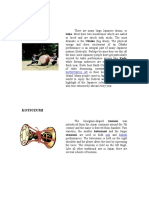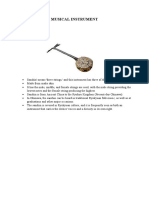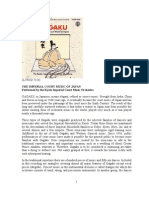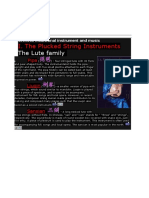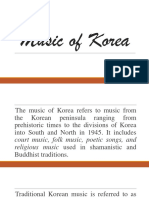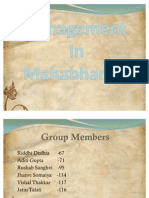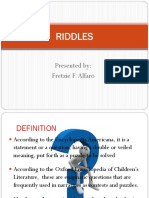Joven
Joven
Uploaded by
Zandrex SalvadorCopyright:
Available Formats
Joven
Joven
Uploaded by
Zandrex SalvadorOriginal Title
Copyright
Available Formats
Share this document
Did you find this document useful?
Is this content inappropriate?
Copyright:
Available Formats
Joven
Joven
Uploaded by
Zandrex SalvadorCopyright:
Available Formats
The shamisen (also called the sangen), a three-string lute with a fret-less fingerboard (about 38 inches long in Jiuta
style), is one of the main instruments used in many Japanese musical traditions. Its construction is elegant and refined, consisting of a long narrow wooden neck, a resonating wooden box covered both sides with animal skin, and a set of woven silk strings stretched over a water buffalo horn, tortoiseshell or wooden bridge.
One of the more recognizable instruments of Japan, the koto consists of a 6 foot long shallow resonating box (made from Paulownia wood) with a set of thirteen strings stretched over movable ivory bridges. This arrangement creates a harp-like instrument which is traditionally played at floor level by a kneeling musician. The player has tsume (plectra) attached to three fingers and strums and plucks the strings. Higher pitches can be created by pressing down to varying degrees on strings behind the bridges. Introduced from China in about the eighth century AD, the koto was originally part of the court orchestra called Gagaku. The oldest existing repertoire for the koto outside of Gagaku dates back to the end of the 16th century. Later in the Edo period (1603-1868) the koto joined the shamisen in small chamber ensembles. This was a tremendously active period in the arts and many parallel genres of music evolved. Music making was one of the allowed professions for blind people and was partially subsidized by the government.
The shakuhachi is Japan's vertical bamboo flute with five finger holes, four in front and one at the back. It is an ancient instrument and yet, due to its versatility, it has a uniquely contemporary appeal. Related to similar flutes found in China, India and the Middle East, The shakuhachi was first introduced into Japan around the end of the 7th century AD and evolved through a series of modifiations until it reached its present form during the 17th. century.
The biwa (lute) arrived in Japan from China and Korea approximately 1300 years ago, with what is still Japans orchestra of the court, Gagaku. There is also evidence that other biwa instruments came from the Indian lute tradition. In the 9th century the Ms (blind monks') biwa began to be used by blind musicians as an accompaniment to chanted religious texts and sutras. At the beginning of the 13th century, Heikebiwa players began telling of tales of the rise and fall of the Taira clan in 12th C Japan. Its performance style has been refined over the years so that it can create scenes and enhance imagery in such a manner as to bring stories to dramatic life before the audience. It has a uniquely expressive sound with the potential to create drama by powerfully plucked sets of notes interspersed with quieter passages. Often, performance traditions use biwa music as interludes inserted between passages of sung narration. The traditional instrument (about three feet long) is commonly made of mulberry (or rosewood, quince) and paulownia woods with silk strings stretched over fixed wooden and bamboo frets.
Shimedaiko (Stick Drum)
roperly speaking, this drum is called Sarugaku taiko, and is widely used in Noh, Nagauta and Kagura. This drum entered Japan with Gigaku from the Korean kingdom of Kudara long ago in the Asuka period. Then it was used in Dengaku and Sarugaku and then underwent various changes with the beginning of Noh and became an essential part of the Noh ensemble. In the Edo period, together with the other instruments of the Noh flute and percussion ensemble, it became an important part of Nagauta and other popular music forms. It is only used in some Noh plays, but when it is used, it only is played in the climactic final half of the play to create an exciting effect.
You might also like
- Song Lyrics Analysis 1Document2 pagesSong Lyrics Analysis 1Crissy cave100% (2)
- Abraham Yakubu Do Not Glory Yet PDFDocument20 pagesAbraham Yakubu Do Not Glory Yet PDFcrystleagle100% (3)
- Bram Stoker's Dracula SCRIPTDocument35 pagesBram Stoker's Dracula SCRIPTAtenas Méndez Mendoza50% (2)
- Japanese MusicDocument8 pagesJapanese Musicapi-539618676100% (1)
- History and DevelopmentDocument30 pagesHistory and DevelopmentYerasimos Dimovasilis100% (1)
- The Traditional Instruments of Japanese MusicDocument4 pagesThe Traditional Instruments of Japanese MusicSamantha PeraltaNo ratings yet
- Japan MusicDocument7 pagesJapan MusicRichelle MallillinNo ratings yet
- Japanese Musical InstrumentsDocument5 pagesJapanese Musical Instrumentsjosiah venice100% (1)
- Gagaku InstrumentsDocument12 pagesGagaku Instrumentsgabrielluis08No ratings yet
- Japanese InstrumentDocument13 pagesJapanese InstrumentDaddyDiddy Delos ReyesNo ratings yet
- East-Asian-Music 8 LC 2Document43 pagesEast-Asian-Music 8 LC 2Mark CantubaNo ratings yet
- Presentation 1Document4 pagesPresentation 1Family MedelladaNo ratings yet
- Differentiate Matter, Molecule, AtomDocument9 pagesDifferentiate Matter, Molecule, AtomAngelica AnneNo ratings yet
- SPA MUSIC LRM G10 Q3 WORLD MUSIC Week 78Document9 pagesSPA MUSIC LRM G10 Q3 WORLD MUSIC Week 78PRINCES SARAH REYES PERALTANo ratings yet
- Music of JapanDocument35 pagesMusic of JapanAlfredo Runas Jr.100% (1)
- Japanese Musical InstrumentsDocument3 pagesJapanese Musical InstrumentsShanie LouNo ratings yet
- Musical Instrument: SanshinDocument5 pagesMusical Instrument: SanshinFadhil HashimNo ratings yet
- Korean Musical InstrumentsDocument5 pagesKorean Musical InstrumentsAndriaKim100% (1)
- MUSIC-and-ARTS-Reviewer-2nd-QuarterDocument10 pagesMUSIC-and-ARTS-Reviewer-2nd-QuartertrixzanegNo ratings yet
- Japan InstrumentDocument2 pagesJapan InstrumentRjvm Net Ca FeNo ratings yet
- Korean Musical InstrumentsDocument5 pagesKorean Musical InstrumentsAndriaKim100% (1)
- Eastasianmusic 161020035102Document69 pagesEastasianmusic 161020035102Jonna Wayne IbanezNo ratings yet
- Lesson 1 - Instrumental Music of East Asia PDFDocument94 pagesLesson 1 - Instrumental Music of East Asia PDFSamantha Chloe PalouNo ratings yet
- Secondary Music 8 Q2 Week3Document18 pagesSecondary Music 8 Q2 Week3Nelson Jeff Jr. MagpaliNo ratings yet
- Japanese MusicDocument16 pagesJapanese MusicNetski's SweetsNo ratings yet
- Japanese music,-WPS OfficeDocument4 pagesJapanese music,-WPS Officenwushie,James ezekielNo ratings yet
- The Imperial Court Music of JapanDocument4 pagesThe Imperial Court Music of JapanFrancisco Javier González-Velandia GómezNo ratings yet
- 2nd Quarterly ReviewerDocument6 pages2nd Quarterly ReviewerSwyne FaytarenNo ratings yet
- East Asian MusicDocument69 pagesEast Asian MusicClaire Montero-MasutaNo ratings yet
- Spec 2 Marcial C. Emia JRDocument27 pagesSpec 2 Marcial C. Emia JREdsil Jess AdalidNo ratings yet
- Japanese and Korean Musical InstrumentDocument14 pagesJapanese and Korean Musical InstrumentNoah CofinoNo ratings yet
- Grade 8 Quarter 2 MusicDocument44 pagesGrade 8 Quarter 2 MusicTrisha Jane Araus FelecildaNo ratings yet
- MUSIC AND ARTS REVIEWER 2nd QUARTER GRADE 8Document6 pagesMUSIC AND ARTS REVIEWER 2nd QUARTER GRADE 8Grace Anne C. MercadoNo ratings yet
- Eastasianmusicgrade8 141021230456 Conversion Gate01Document183 pagesEastasianmusicgrade8 141021230456 Conversion Gate01Jayson Peralta ValdezNo ratings yet
- Music of East AsiaDocument2 pagesMusic of East AsiaXia Lee MarNo ratings yet
- Japanese Art Music - Ancient TraditionsDocument28 pagesJapanese Art Music - Ancient TraditionsEdsil Jess AdalidNo ratings yet
- Project PDFDocument3 pagesProject PDFchristleanneNo ratings yet
- Japanese MusicDocument50 pagesJapanese MusicMica Dump100% (1)
- East Asian MusicDocument3 pagesEast Asian MusicMerrie Anne Pascual Bagsic100% (1)
- DISCUSSION East Asian Instrumental MusicDocument35 pagesDISCUSSION East Asian Instrumental MusicHillish SatanicNo ratings yet
- MAPEH 8 2ndDocument36 pagesMAPEH 8 2ndjoseph venturaNo ratings yet
- Japan World MusicDocument32 pagesJapan World Musicapi-295865391No ratings yet
- 2nd QUARTER MUSIC GRADE 8 MODULEDocument7 pages2nd QUARTER MUSIC GRADE 8 MODULEYeye Lo Cordova100% (4)
- East Asian MusicDocument32 pagesEast Asian MusicXyrone SolimanNo ratings yet
- 00 - Ensemble Yonin No Kaï - Ocora Japon, Sankyoku, Ensemble Yonin No KaïDocument1 page00 - Ensemble Yonin No Kaï - Ocora Japon, Sankyoku, Ensemble Yonin No KaïRoberto MacielNo ratings yet
- Japanese InstrumentsDocument2 pagesJapanese InstrumentsRuel VillanuevaNo ratings yet
- q2 Music East Asian MusicDocument53 pagesq2 Music East Asian MusicMark Joshua MandaniNo ratings yet
- Traditional Chinese InstrumentsDocument5 pagesTraditional Chinese InstrumentsChe'ras IbrahimNo ratings yet
- q2 Music (East Asian Music) (Autosaved)Document48 pagesq2 Music (East Asian Music) (Autosaved)Jared OrdoñezNo ratings yet
- E31 Music JapanDocument4 pagesE31 Music JapanTara KentNo ratings yet
- 6 Traditional Japanese Instruments - TodayDocument7 pages6 Traditional Japanese Instruments - TodayBubble GumNo ratings yet
- PipaDocument5 pagesPipaJennifer HengNo ratings yet
- Traditional Japanese MusicDocument8 pagesTraditional Japanese MusicGamingWithCactus ReactesNo ratings yet
- Q2-East Asian MusicDocument58 pagesQ2-East Asian MusicPARAY AGUINALDONo ratings yet
- Project IN Mapeh: "Japanese Musical Instruments"Document6 pagesProject IN Mapeh: "Japanese Musical Instruments"Wennivie MarinduqueNo ratings yet
- Hua Yanjun (1893-1950) and Liu Tianhua (1895-1932)Document11 pagesHua Yanjun (1893-1950) and Liu Tianhua (1895-1932)Mandy ChengNo ratings yet
- Music of JapanDocument56 pagesMusic of JapanIsselb RamosNo ratings yet
- BuratchiDocument6 pagesBuratchiJohn Gerard CulminasNo ratings yet
- TarubDocument6 pagesTarubJohn Gerard CulminasNo ratings yet
- Ryūteki: Otsuzumi. They Are Used in BothDocument5 pagesRyūteki: Otsuzumi. They Are Used in BothCassandra LopezNo ratings yet
- Music of Korea and JapanDocument47 pagesMusic of Korea and JapanArt Montallana PomarejosNo ratings yet
- Dark Gray Red History China Educational PresentationDocument19 pagesDark Gray Red History China Educational Presentationma.jeanpatulayinNo ratings yet
- Deep Magic February 2004Document73 pagesDeep Magic February 2004Deep MagicNo ratings yet
- Kidnap Reader AnswersDocument1 pageKidnap Reader Answerslinda MargaritaNo ratings yet
- Quintin Kynaston School: History.Document2 pagesQuintin Kynaston School: History.John_Adam_St_Gang_QKNo ratings yet
- COLOUR PsycologyDocument4 pagesCOLOUR PsycologyNazimNo ratings yet
- Music NotesDocument5 pagesMusic Notesmusic lifeNo ratings yet
- Deathball v1.1Document3 pagesDeathball v1.1gantherogueNo ratings yet
- Kaplan GRE® Premier 2014 With 6 Practice Tests 542Document1 pageKaplan GRE® Premier 2014 With 6 Practice Tests 542dr.misticNo ratings yet
- Quest Unit 5 Animal ZoneDocument7 pagesQuest Unit 5 Animal Zonerotrejo.tucNo ratings yet
- 1949 Baby Girl Names-Complete List For Mobile Devices-10268 Names PDFDocument139 pages1949 Baby Girl Names-Complete List For Mobile Devices-10268 Names PDFDhruva Chodankar100% (1)
- Management in MahabharatDocument14 pagesManagement in MahabharatVishal ThakkarNo ratings yet
- Wild West DBQDocument10 pagesWild West DBQTatic SenadNo ratings yet
- Load Distribution Factors For Hollow Core Slabs WithDocument1 pageLoad Distribution Factors For Hollow Core Slabs WithsushilNo ratings yet
- Const Estimate Made Easy by Engr Cajilla V0 99Document25 pagesConst Estimate Made Easy by Engr Cajilla V0 99Al Patrick Dela CalzadaNo ratings yet
- Grade 1 CredoDocument4 pagesGrade 1 CredoMary Claire EnteaNo ratings yet
- Ideas by Gul Ahmed PresenstationDocument29 pagesIdeas by Gul Ahmed PresenstationAnita AzharNo ratings yet
- Unit 4 Vocab + Grammar Extra Practice - Answer Key PDFDocument4 pagesUnit 4 Vocab + Grammar Extra Practice - Answer Key PDFYesenia RodriguezgordilloNo ratings yet
- Edgar Allan Poe PowerpointDocument16 pagesEdgar Allan Poe PowerpointCatherine MortonNo ratings yet
- Pertemuan7 Hendra Ekky SaputraDocument6 pagesPertemuan7 Hendra Ekky SaputraHendra DevgruNo ratings yet
- Bibliografie SociologieDocument2 pagesBibliografie SociologieMaran IoanaNo ratings yet
- COMPARISONNoli&El Fili 2019Document2 pagesCOMPARISONNoli&El Fili 2019Milvy Faith C. SyjongtianNo ratings yet
- "Coffee Drinks": - GrindDocument2 pages"Coffee Drinks": - GrindJun RekNo ratings yet
- RiddlesDocument17 pagesRiddlesMark J. FanoNo ratings yet
- Tolkien EssayDocument4 pagesTolkien EssayJohn AllenNo ratings yet
- Contents For TeX Unbound! - 13Document5 pagesContents For TeX Unbound! - 13Sándor NagyNo ratings yet
- Style Guide 1.0Document13 pagesStyle Guide 1.0Devin BushNo ratings yet
- Brand Positioning of MaggiDocument11 pagesBrand Positioning of MaggiAryan Sp33% (3)
- The Path To Holiness by Jesse C. JonesDocument134 pagesThe Path To Holiness by Jesse C. JonesSandra Crosnoe0% (1)









